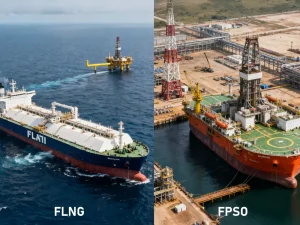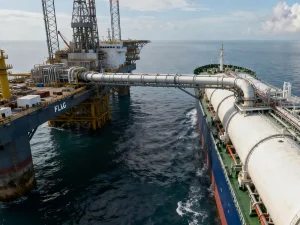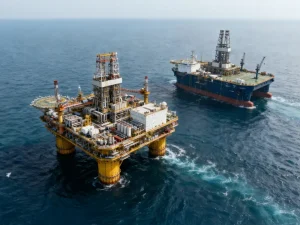Несомненно, добыча энергии на шельфе становится все более популярной. Крупные компании добывают нефть и природный газ из подводных скважин. В этом процессе они используют СПГ и FPSO, чтобы обеспечить рентабельность и эффективность добычи нефти и газа. Однако эти два объекта различаются, что приводит к спору между FLNG и FPSO.
Спор идет не о том, какое судно или плавучее сооружение лучше. Наоборот, люди обычно путают их по назначению и случаю использования. Помните, что FPSO - это добыча, переработка и хранение нефти. С другой стороны, в процессе FLNG происходит сжижение и хранение природного газа. В этой статье я расскажу обо всех различиях между FLNG и FPSO.
Обзор FLNG и FPSO

В предыдущей статье, Я сравнил FSO и FPSO. Оба этих судна связаны с сырой нефтью и ее переработкой. Однако FLNG уникален и не имеет ничего общего с сырой нефтью и ее хранением.
FLNG расшифровывается как "плавучая установка для сжиженного природного газа". Это плавучее сооружение или судно, оснащенное газоперерабатывающим оборудованием. Оно забирает природный газ (сырой) со дна моря. Затем он обрабатывается, фильтруется и сжижается при очень низкой температуре. Этот сжиженный природный газ хранится в корабельном контейнере или резервуаре.
Сжиженный природный газ остается на судне. Как только контейнер заполняется, прибывает отдельный СПГ-перевозчик (небольшое судно) и забирает сжиженный газ из СПГ. В результате разгрузки контейнер становится готовым к приему поступающего газа. Таким образом, СПГ продолжает работать и добывать газ с морского дна.
Представьте себе, что сырой природный газ проходит очистку и фильтрацию для удаления воды и других примесей. Все это происходит на FLNG, что говорит о том, насколько хороши эти суда! FPSO отличаются тем, что они больше занимаются добычей и переработкой нефти.
FPSO - это "плавучая установка для добычи, хранения и разгрузки". Эти суда добывают сырую нефть (смешанную с водой) с морского дна. После этого они фильтруют и перерабатывают сырую нефть, чтобы получить полностью отфильтрованную, чистую нефть. Они хранят эту нефть в резервуарах, а затем выгружают ее на танкеры или небольшие суда.
Иногда сырая нефть также содержит воду и газ. Но на FPSO используется процесс сепарации для фильтрации и удаления этих газов. Интересно, что эти газы находятся в розыске и не хранятся. Проще говоря, FPSO только обрабатывает, перерабатывает и хранит нефть. Как и судно FLNG, это судно также имеет на борту оборудование, но оно предназначено для переработки сырой нефти.
В чем разница между FLNG и FPSO?
Получили основное представление о FLNG и FPSO? Давайте обсудим существенные различия между этими двумя плавучими сооружениями или судами.
1- Рабочий процесс

FLNG и FPSO различаются по основным принципам работы. FLNG находится над газовым месторождением, расположенным на подводном уровне. Они извлекают природный газ из этих месторождений. Добытый природный газ является сырым и содержит множество загрязняющих веществ. FLNG оснащен современным оборудованием, которое фильтрует и очищает природный газ. После этого очищенный природный газ проходит еще один процесс сжижения.
При сжижении природный газ превращается в жидкость. Каким образом? Это происходит путем снижения температуры до -160 градусов Цельсия. Затем сжиженный природный газ (СПГ) хранится в криогенных резервуарах и выгружается на специализированные суда для перевозки СПГ. С другой стороны, FPSO добывают сырую нефть из подводных скважин. Поскольку это сырая нефть, она содержит множество загрязняющих веществ.
К ним относятся смешанная вода, газы и другие химические вещества. На FPSO установлено современное оборудование для обработки и переработки нефти. Так, смесь воды, газов и других химических веществ отфильтровывается. Чистая нефть затем хранится в танкерах-хранилищах FPSO. Помните, что FPSO только перерабатывает и фильтрует нефть, а FLNG перерабатывает природный газ и производит СПГ.
2- Функция и назначение
И FLNG, и FPSO помогают производить энергию, не требуя строительства крупных заводов. Помните, что строительство большого завода по переработке сырой нефти или природного газа обойдется очень дорого. И FLNG, и FPSO - это плавучие суда или установки, которые перерабатывают природный газ и сырую нефть соответственно. Однако FLNG перерабатывает только природный газ и производит СПГ.
С другой стороны, FPSO специализируется только на нефти. Как я уже упоминал, сырая нефть транспортируется из подводных скважин на FPSO. через шланги и трубопроводы. Природный газ также перекачивается на СПГ по трубопроводам. FPSO фильтрует, перерабатывает, хранит и выгружает нефть. С другой стороны, СПГ перерабатывает природный газ, сжижает его и хранит.
3- Потребление и обработка энергии
Я считаю, что СПГ - более энергоемкая установка для производства СПГ или плавучее сооружение. Почему? Причина в том, что СПГ приходится пропускать природный газ через процесс сжижения. В этом процессе для охлаждения газа используются сверхмощные компрессоры и холодильные установки. Помните, что эти компрессоры могут достигать температуры до -160°C.
Таким образом, эти компрессоры потребляют больше энергии, что делает FLNG более дорогим. С другой стороны, FPSO также потребляют энергию при переработке сырой нефти. Небольшие нефтеперерабатывающие заводы и фильтровальные установки требуют энергии для своей работы. Однако они потребляют не так много энергии, как установки и суда FLNG. Управлять обоими судами очень сложно.
Оба они создают разные проблемы при обращении с ними. Как? FLNG производит СПГ (очень холодную жидкость). С другой стороны, FPSO производят легковоспламеняющуюся нефть. В случае неправильного обращения это приведет к серьезным последствиям. Поэтому операторы и члены экипажей как FLNG, так и FPSO должны быть начеку.
4- Тип хранения и способ разгрузки

FPSO относительно легче хранить, и их разгрузка также не представляет особой сложности. Почему? Причина в том, что на FPSO перерабатывается легковоспламеняющаяся нефть, которая не требует никаких условий окружающей среды. Она хранится при нормальном давлении и температуре.
Поэтому ее можно хранить в обычных контейнерах или в резервуарах FPSO. Кроме того, эту очищенную нефть можно легко перегрузить на любое судно. Однако СПГ перерабатывает природный газ, сжижает его и охлаждает до очень низких температур. Сжиженный природный газ (СПГ) требует очень низких температур при хранении. Поэтому сжиженный газ хранится в криогенных резервуарах.
Эти резервуары обладают свойствами, позволяющими поддерживать очень низкие температуры (-160°C). В результате СПГ остается в хорошем состоянии. Кроме того, для выгрузки СПГ из криогенных резервуаров требуются специализированные суда-перевозчики СПГ. Эти суда могут безопасно транспортировать СПГ на следующий объект. Они делают это безопасно благодаря своей способности поддерживать очень низкие температуры.
5- Оборудование и безопасность
Как я уже говорил, FPSO и FLNG - это плавучие суда или установки, на которых установлено крупногабаритное оборудование. Это оборудование помогает им перерабатывать сырую нефть или природный газ, соответственно. Верно? Однако они различаются по ключевому оборудованию на борту. На FPSO размещено такое оборудование, как сепараторы, резервуары для хранения, установки для переработки нефти и нефтепереработки.
С другой стороны, на СПГ также имеется оборудование для переработки и сжижения природного газа. Это холодильные установки, компрессоры, криогенные резервуары и многое другое. Это оборудование помогает перерабатывать природный газ и превращать его в СПГ. Что касается безопасности, то и FLNG, и FPSO оснащены некоторыми средствами защиты.
FPSO оснащен системой контроля температуры для поддержания умеренной температуры. На нем также имеются огнетушители и некоторые другие средства для ликвидации аварий. С другой стороны, СПГ также более безопасны благодаря системам обнаружения утечек и контроля давления. Однако экипаж и сотрудники должны быть осторожны и следовать инструкциям, чтобы обеспечить безопасность как на СПГ, так и на FPSO.
6 - Развертывание и срок службы
Развертывание FPSO относительно проще, чем развертывание FLNG. Для этого используется многочисленные морские подушки безопасности и другое оборудование. Кроме того, развертывание FPSO занимает меньше времени, что позволяет быстрее проводить операции. После развертывания FPSO может прослужить почти 15-20 лет. С другой стороны, СПГ очень сложны, и их развертывание сопряжено с определенными трудностями.
Причина в том, что эти СПГ состоят из множества тяжелых единиц оборудования, таких как компрессоры и криогенные резервуары. Поэтому их эксплуатация требует более тщательного контроля и ухода. Что касается срока службы, то СПГ может прослужить от 20 до 25 лет. Почему? Причина в том, что эти морские суда изготавливаются из сверхпрочных материалов. Поэтому они устойчивы к водным условиям и работают лучше и дольше.
7- Стоимость и сложность
FPSO являются экономически эффективным вариантом по сравнению с СПГ. Почему? Причина в том, что FPSO изготавливаются из доступных материалов. Для них не требуются высокотехнологичные системы хранения, такие как криогенные резервуары. Кроме того, они состоят только из нефтеперерабатывающих установок, которые относительно проще в производстве. Кроме того, их эксплуатация и обслуживание также менее сложны, чем у FLNG.
Почему СПГ дороже? В основном из-за материалов и оборудования на борту. Они состоят из сверхмощных компрессоров и холодильных установок для сжижения природного газа. Кроме того, они оснащены криогенными резервуарами, которые стоят очень дорого. Эти цистерны предназначены для поддержания низкой температуры около -160°C.
Все это оборудование и компоненты делают СПГ очень дорогостоящим. Запуск, обслуживание и эксплуатация СПГ сложны и трудны. Для управления СПГ требуется высокая квалификация персонала или экипажа. Запуск СПГ занимает много часов, что говорит о его сложности.
Заключение
Как я уже сказал, FLNG против FPSO - это не вопрос, что лучше. Верно? Главное - понять их различия и познакомиться с ними поближе. Помните, что оба этих судна или плавучие единицы служат для разных целей и задач. Например, FLNG добывает природный газ из подводных месторождений, сжижает его, хранит и затем выгружает.
С другой стороны, FPSO работает только с сырой нефтью. Если сырая нефть содержит смешанные газы, FPSO фильтрует газ, выпускает его, хранит только очищенную нефть, а затем выгружает ее. Для добычи газа лучше всего подходят СППГ. С другой стороны, FPSO могут справиться с работой, когда речь идет о подводной добыче сырой нефти.
